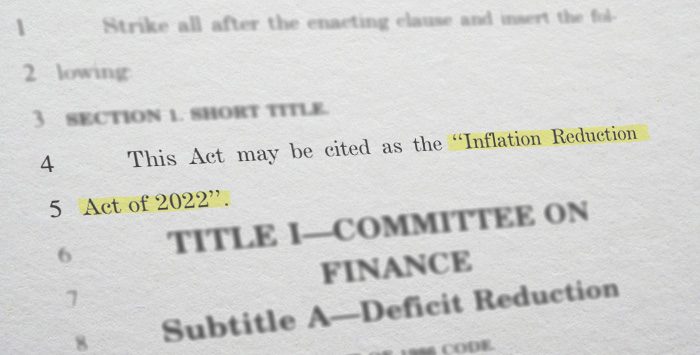The Inflation Reduction Act, enacted in 2022, has been phasing in various changes to Medicare drug coverage — mostly Part D, but also Part B, as discussed below. Here’s where enrollees are most likely to see their costs and benefits affected by the IRA:
$2,000 cap on Part D out-of-pocket costs in 2025
One of the most highly anticipated IRA improvements will take effect in 2025. At that point, there will be a $2,000 cap on out-of-pocket costs under Medicare Part D (including stand-alone Part D plans and Part D coverage integrated with Medicare Advantage plans). This will include the deductible and any copays or coinsurance that enrollees pay for drugs that are covered by their plan. The Part D “donut hole” will no longer exist as of 2025. The out-of-pocket limit will continue to apply in future years, although the amount could increase above $2,000 if Medicare’s per-enrollee drug spending increases.
Starting in 2024, the IRA had already eliminated Part D out-of-pocket costs for covered drugs once an enrollee reached the catastrophic coverage level. That effectively implemented an out-of-pocket limit of roughly $3,300. Before 2024, enrollees paid 5% of the cost of covered drugs once they reached the catastrophic coverage level, and there was no limit on how high out-of-pocket costs could be under Medicare Part D. About 1.5 million Medicare Part D enrollees had prescription drug costs that put them above the catastrophic coverage level in 2019.
Starting in 2025, people with Medicare Part D will have the option to spread their out-of-pocket costs across the full year. Enrollees can opt into this by contacting their Part D plan, and will then be able to pay their out-of-pocket costs in equal monthly payments, instead of having to meet their out-of-pocket limit early in the year. This is detailed in Section 11202 of the Inflation Reduction Act.
Full Extra Help available to more Medicare Part D enrollees
Medicare’s Extra Help program (also known as the Low-Income Subsidy) provides financial assistance that can make prescription drugs and Medicare Part D prescription drug (Part D) premiums more affordable for policyholders. Starting in 2024, full Extra Help is available to enrollees with income up to 150% of the federal poverty level (FPL), as long as their assets are within the eligible range. This was an expansion of the benefit, as full Extra Help was previously only available up to 135% FPL, and those with income between 135% FPL and 150% FPL were only eligible for partial Extra Help.
For 2024, the income limit for Extra Help eligibility in the continental U.S. is $22,590 for a single person or $30,660 for a married couple.
In 2024, the asset limit is $17,220 for a single individual or $34,360 for a married couple; these limits are indexed each year. Some assets are not counted, such as your primary home and your vehicles.
According to the U.S. Department of Health and Human Services, the eligibility expansion for full Extra Help was expected to make the program newly available to 300,000 low-income Medicare beneficiaries.
Know someone who might be eligible for Extra Help? The Social Security Administration has information about applying for this benefit.
Learn more about Extra Help.
How Part D premiums changed for 2024 and 2025
Overall, the average premium for a stand-alone Part D plan (PDP) is $41.63/month in 2024, and is projected to decrease slightly, to $40/month, in 2025. But there will be fewer stand-alone Part D plans available in 2025: There were a total of 709 Part D plans available across the country in 2024, and that’s dropping to 524 plans in 2025.
Since the IRA is shifting more drug costs onto Part D plans, there were concerns that premiums might increase significantly or plans might exit the market in 2025. So CMS has introduced a one-year premium stabilization program for stand-alone Medicare Part D plans.
The program will give participating insurers $15/month for each enrollee, to offset what would otherwise have been higher premiums for enrollees. Participating insurers must limit premium increases to no more than $35/month. CMS noted that 99% of people with stand-alone Part D plans are in plans that have opted into the premium stabilization program, and average stand-alone Part D premiums are decreasingly slightly for 2025. But a KFF analysis indicates that many participating insurers are imposing a rate increase of exactly $35/month.
The projected $40/month average premium for stand-alone Part D plans in 2025 is similar to what average premiums had been in the several years before the IRA was enacted.
One of the provisions under the IRA that impacted Part D premiums starting in 2024 was the capping of Medicare Part D national base beneficiary premium (NBBP) that took effect in 2024. (The NBBP is calculated by the federal government, based on bids submitted by plans and a formula that’s set in statute; starting with the 2024 plan year, that formula changed to include the cap set by the IRA.)
This cap limits the NBBP to no more than 6% higher than it was the year before. But while consumers may expect the IRA’s cap to directly limit how much their Part D premiums increase, it’s more complicated than that:
- The base beneficiary premium isn’t the only factor affecting Part D premiums – it’s just the starting point. Plan-specific premiums for basic coverage are calculated by adjusting the NBBP by how much the plan’s bid amount differs from the national average bid. (So if the plan’s bid is lower than the national average bid, the plan-specific basic premium will be lower than the NBBP, and if the plan’s bid is higher than the national average bid, the plan-specific basic premium will be higher than the NBBP). And for plans with supplemental/enhanced benefits, the additional supplemental premium is then added to get the total premium. So while the base beneficiary premium for 2024 was 6% higher than it was in 2023, a specific plan’s rate increase could still be much more significant. For more information, this brief from CMS explains how the base beneficiary premium is used to calculate plan-specific premiums for each plan’s basic benefit.
- Though CMS announced that average total Part D premiums (including basic and supplemental benefits) would be slightly lower in 2024 than in 2023, those decreases were an average. We saw significant rate changes – both increases and decreases – for some plans. For 2025, average total Part D premiums are again decreasing, from $53.95 in 2024 to $46.50 in 2025. But there will still be a wide range of plans available, with a wide range of premiums.
- There is also tremendous variation from one Part D plan to another: For the 2024 plan year, premiums for stand-alone Part D plans range from $0/month to over $100/month. The number of enrollees paying $0/month is roughly the same as the number of enrollees who are paying at least $100/month. So averages don’t really tell the whole story. And although average Part D premiums are decreasing slightly for 2025, there will continue to be a lot of variation from one plan to another, both in terms of total premiums and premium changes for 2025.
So although there is now a cap on the NBBP, enrollees should know that actual premium changes – increases or decreases – for a specific plan can still be much larger than 6%. So enrollees must compare all of the plan options that are available to them during open enrollment each fall.
(It’s also important to note that the Part D late enrollment penalty is based on the national base beneficiary premium. So the cap on the base beneficiary premium means that people who pay a Part D late enrollment penalty will pay a slightly smaller penalty in 2024 and future years than they would have paid without that cap.)
IRA provisions focused on reducing drug costs
In addition to addressing out-of-pocket costs and premiums for Medicare Part D, the IRA also included provisions to address the amount that beneficiaries, the government, and insurers pay for prescription drugs covered by Medicare Part D and Part B.
Medicare Prescription Drug Inflation Rebate Program
Since the start of 2023, the IRA has been requiring prescription drug manufacturers to pay rebates to Medicare if the price of their drugs increases faster than inflation. The Department of Health and Human Services will start to send rebate invoices to drug manufacturers in 2025.
And, since April 2023, Medicare Part B enrollees who use certain medications may have seen reduced cost-sharing/coinsurance for drugs whose prices have increased faster than inflation.
The list of drugs with reduced coinsurance changes each quarter. As of the third quarter of 2024, there were 64 prescription drugs covered under Medicare Part B that have reduced cost-sharing as a result of the IRA’s Inflation Rebate Program. But as of the fourth quarter of 2024, there are only 54 drugs on the list.
For those drugs, the Medicare Part B coinsurance rate is lower than the 20% that normally applies to services covered under Part B. (Part B-covered drugs are certain drugs that are administered in a medical office by infusion or injection; most drugs are covered under Part D instead, and are not affected by this program.) If a beneficiary has supplemental coverage — from Medicaid, Medigap, or an employer’s health plan — that pays their Part B coinsurance, they won’t notice a difference. But if a beneficiary pays their own Medicare Part B coinsurance and uses a drug that’s subject to the rebates, they will notice lower out-of-pocket costs.
A similar rebate system already operates in the Medicaid program, and plays a significant role in keeping drugs costs lower for Medicaid.
Medicare drug price negotiation underway; lower costs begin in 2026
As a result of the IRA, Medicare can negotiate pricing with drug manufacturers — something that was previously forbidden. The price negotiations apply to a fairly small subset of drugs. But they are some of the most expensive drugs, and relatively few drugs account for the majority of Medicare’s drug spending. The first year of negotiated rates, applicable to 10 drugs, will be 2026. But the process began in 2023.
In September 2023, HHS published a list of ten Part D drugs that would be subject to negotiation (selected from among the 50 qualifying drugs with the highest spending; various rules apply here, including the fact that the drugs must have been on the market for several years and not have generic alternatives).
HHS then negotiated with the drug manufacturers, following the protocol outlined in the IRA. And in August 2024, HHS published the negotiated prices that will take effect in 2026 for those ten drugs.
This process will continue for each of the next few years, with additional drugs added to the negotiation process each year through 2029. Another 15 drugs will be added for 2027, 15 more will be added for 2028, and 20 more will be added for 2029. So by that point, there will be 60 drugs subject to negotiation, all of which will be among the most expensive drugs that don’t have generic alternatives. In the latter two years, the newly added drugs will potentially be a mix of Part D and Part B drugs, whereas the negotiated rates in 2026 and 2027 will all apply to Part D drugs.
Drug manufacturers that do not comply with the negotiation process will be subject to financial penalties. Alternatively, they can choose to no longer have their drugs covered under the Medicare and Medicaid programs.
Capped insulin copays and zero-cost vaccines continue
In addition to those changes, several provisions of the IRA that reduced costs for many Medicare beneficiaries in 2023 continue to benefit enrollees in 2024 and future years:
- All insulin products covered by Part D plans now have copays capped at $35. This also applies to insulin covered by Part B, for use in insulin pumps (Part B operates with a coinsurance system rather than a copay system, but the coinsurance for insulin cannot exceed $35 per month). CMS has a list of frequently asked questions about the $35 insulin cost-sharing cap.
- If your Part D plan has a deductible, the deductible does not apply to insulin. For insulin covered under Part B, for use in insulin pumps, the Part B deductible does not apply.
- Vaccines recommended by the ACIP (Advisory Committee on Immunization Practices) covered by Medicare Part D – including Tdap, hepatitis A, hepatitis B (for low-risk individuals), shingles, and RSV – have no out-of-pocket costs (the RSV vaccine for older adults was approved in 2023, and is covered by Part D plans without cost-sharing; Tdap, Hep A and B, and shingles vaccines were already covered by Part D plans before the IRA, but often with copays and deductibles; the IRA eliminated the cost-sharing). Vaccines for flu, COVID, pneumonia and hepatitis B (for medium/high-risk individuals) were already covered under Medicare Part B with no out-of-pocket cost and that continues to be the case.
Note that GLP-1 receptor agonists are not insulin and are thus not subject to the IRA’s insulin price cap. Here’s more about Medicare coverage of GLP-1s.
Note also that Part D plans still have formularies that determine which insulin products they cover; different plans will cover different insulins. If your plan doesn’t cover a particular insulin, you would have to pay full price for it, and it would not count toward your out-of-pocket cap. You can ask your doctor to prescribe an insulin that is covered by your plan, and also know that you can switch to a different Part D plan during the open enrollment period if it would better meet your needs.
Don’t pass on the opportunity to review your Part D costs
Medicare’s open enrollment period runs from October 15 to December 7. If you’re enrolled in Medicare, this is your opportunity to make a change to your Part D coverage, either under a stand-alone Part D plan (PDP) or a Medicare Advantage plan that includes Part D coverage (MA-PD).
Even if you’re happy with your current drug coverage, it’s worth your while to compare the available options for the coming year. Make sure you know how much your premium will be changing in January and whether your plan will make changes to its cost-sharing or deductibles. (For example, the deductible for standard plans is increasing from $545 in 2024 to $590 in 2025.)
You’ll also want to understand what your costs might be under the other plans that are available in your area.
Louise Norris is an individual health insurance broker who has been writing about individual health insurance and Medicare since 2006. She has written dozens of opinions and educational pieces about Medicare for medicareresources.org. Her analysis is regularly cited by media who cover health reform and by other health insurance experts. The views expressed in this article are those of the author and may not reflect those of medicareresources.org, which is owned by Healthinsurance.org, LLC.
Footnotes
Tags: Inflation Reduction Act, Medicare Part D, prescription drug coverage



